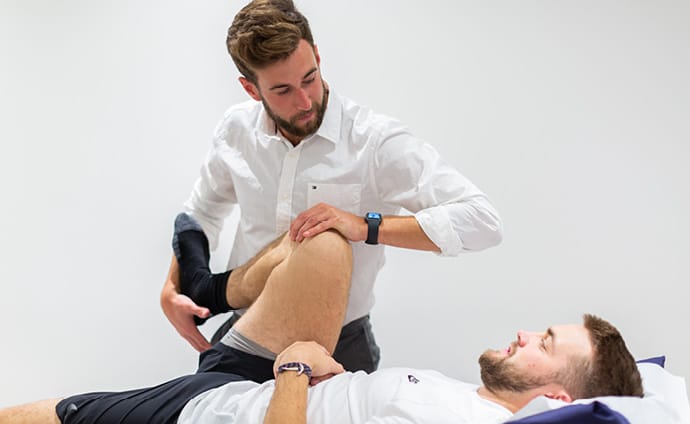So, you’ve been dealing with an injury or chronic pain for a while and don’t know who is the right person to fix it? Friends and family have all been sharing their various opinions with you and each conversation you have leaves you feeling more confused.
Choosing the right healthcare practitioner for you is important, so first understanding the differences between them is crucial. But first, let’s see what they have in common.
What are the similarities between chiropractic, osteopathy and physiotherapy?
All three of these practices deal with the treatment of the musculoskeletal system (made up of your bones, joints and muscles), which is part of the reason it can be confusing trying to choose which one is right for you – depending on the injury or illness, there are certain scenarios where one or all of these treatments could be effective.
The second main similarity is that all of these practitioners have a university-based education and none of them can claim each other’s titles unless they have done the appropriately accredited course, even if they learned some of the same treatments.
Okay, so what makes them different then?
At a high level, the main differences between a chiropractor, osteopath and physiotherapist is their fundamental philosophies about how to treat pain. However, there are some distinct differences in the treatments they offer, which we will break down for you here.

Chiropractors
Chiropractors believe in treating the body holistically, through a focus on your spine. They commonly use manual manipulation or mobilisations of the spine to decrease pain or increase mobility.
Chiropractors most commonly treat lower back pain or neck pain although across the profession there are significant differences in philosophies.
They most commonly treat lower back pain or neck pain although across the profession there are significant differences in philosophies, with some chiropractors offering treatment for other health issues. Some chiropractors may also utilise x-rays, acupuncture, ice, heat, exercises or other lifestyle suggestions, but they will not prescribe medication, so if they feel this is necessary should refer you to another practitioner.
A chiropractor in the UK will need to complete a four-year university degree, or postgraduate master’s course recognised by the General Chiropractic Council. The degree involves three years of full-time study, plus one year working under the supervision of a qualified chiropractor.
Osteopaths
Osteopathy is similar to chiropractic in the sense that it approaches health holistically, predominantly through manual treatment. However, the types of hands-on treatments used by osteopaths are generally gentler and less focussed on manipulation than chiropractic, with an aim of ensuring all the bones, muscles, ligaments and connective tissues are working in harmony with each other.
The types of hands-on treatments used by osteopaths are generally gentler and less focussed on manipulation than chiropractic
They also look at neural pathways and the relationships between organs and their connections with the muscles and joints. Plus, they work on the whole body rather than mainly focusing on the spine like a chiropractor. They are not licensed to take x-rays or prescribe medication, so should refer you to a GP or other practitioner if these treatments are required.
To become a Registered Osteopath in the UK, you must complete a course of training that is recognised by the General Osteopathic Council. A training course is normally then followed by a four-year full-time bachelor’s degree in osteopathy or a postgraduate master’s degree.

Physiotherapists
Like the other two professions, physiotherapists treat the body holistically, however their focus is looking at the surrounding joints near the injury as well as the body as a whole. Physios can specialise in three main different areas: cardiorespiratory, neurological or musculoskeletal.
Physiotherapists treat the body holistically, their focus is looking at the surrounding joints near the injury as well as the body as a whole.
All physio students in the UK will rotate through these three areas as part of their studies, and then those who choose to work in a hospital will gain experience in all three before choosing a specialty.
Physios will treat all bones, joints and muscles, no matter where in the body they are located – from your spine, through to your arm, shoulder, or foot. A physio will assess a patient and based on their experience and specialty; determine which treatment they think will help most. They can also prescribe medication if they feel it’s required.
At a clinic like Spectrum, which specialises in musculoskeletal physiotherapy, we refer to our approach as a 360º approach, which means we combine specialists in different disciplines and the latest technology to create a personalised treatment plan for each patient.
This could mean seeing multiple physios with different specialties and / or exercise scientists and several different treatments including manual manipulations and mobilisations, soft tissue exercises, dry needling, McKenzie therapy, TENS, Shockwave therapy, icing, compression and more.
To practise as a physiotherapist in the UK, you must be registered with the Health and Care Professions Council (HCPC), which means you needs to have successfully completed an approved degree in physiotherapy. This could include a three-year full time bachelor’s degree, or a degree apprenticeship in physiotherapy.
Ultimately, choosing a treatment is a highly personal decision. It’s important that you have a good understanding of what areas or specialities a practitioner covers and who will be best qualified to diagnose and treat you.
And remember, while these three professions might have their differences, so does each practitioner within a disciple. No one should live with pain – so persevere until you find the right professional and treatment for you.
If you’re suffering from an injury or chronic pain, the team at Spectrum are here to help. We look beyond just your symptoms to figure out the cause and then create one-off treatment plan just for you. Get in touch with us today to secure an appointment within 24 hours.



